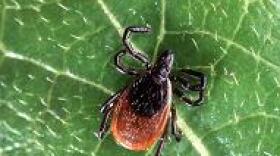A New York state senator from the Hudson Valley is calling for the state budget to include funding for Lyme and tick-borne diseases research, education and prevention initiatives. It comes as other lawmakers and advocates share her hope that the COVID-19 pandemic is not distracting from other health issues, like Lyme.
Republican state Senator Sue Serino’s 41st District includes a large portion of Dutchess County and part of Putnam County — areas with high incidents of Lyme and tick-borne diseases.
“Approximately 8,000 of Lyme disease and more than 1,200 cases of other tick-borne diseases are reported to the New York state Department of Health each year,” says Serino.
Serino, who is recovering from COVID-19, says that with New Yorkers spending even more time outdoors because of COVID and with some crossover between COVID and tick-borne disease symptoms, it is not the time to move backwards.
“According to the CDC, New York ranked second in the nation in reported confirmed cases of Lyme disease. We’re here today because, despite the statistics, the governor’s budget proposal has always been lacking on this front, and it’s always been up the Legislature to add funding for research, education and prevention,” Serino says. “In 2018, we were successful in including an unprecedented $1 million for these efforts, and the Legislature has gone on to secure $250,000 in each of the last two years.”
Serino and a group of bipartisan lawmakers and advocates are calling for the inclusion of resources.
“This year, the governor’s executive budget proposal not only fails to include new funding to combat the spread of Lyme and tick-borne diseases, it even goes so far as to eliminate the measly $69,400 that has been dedicated to the state Department of Health for Lyme and other tick-borne illnesses for research, prevention, detection services and expenses in years past,” says Serino.
She calls it a drop in the bucket for an issue that affects thousands of New Yorkers. Republican State Senator Daphne Jordan of the 43rd District says the lack of funding is insulting.
“Columbia County, all of which is in my Senate district, has been characterized as ground zero for Lyme disease,” says Jordan. “And it’s vital that New York state continue making real progress toward combatting this public health crisis.”
State Senator Tom O’Mara represents the 58th District.
“It is a disgrace this year that Governor Cuomo has zeroed out any money going towards Lyme research,” O’Mara says.
He says there need to be better diagnostic tools. Holly Ahern is associate professor of Microbiology at SUNY Adirondack. She says there is a significant undercount of cases each year, as confirmed by the Centers for Disease Control and Prevention.
“The CDC recently revised their accounting method and used data from insurance databases to estimate Lyme disease cases and, as a result of this investigation, last month, the CDC increased that number to nearly a half-a-million new cases of Lyme disease occurring annually,” Ahern says.
Ahern also is vice president of the Lyme Action Network.
“So, this latest estimate puts Lyme disease in the position of the third most common bacterial infectious disease in the U.S.,” says Ahern.
Dr. Brian Leydet is assistant professor of Environmental & Forest Biology at SUNY College of Environmental Science & Forestry.
“Here in central New York, we’ve seen a 439 percent increase in Lyme disease rates,” says Leydet. “Now, if we overlay other diseases like babesia, anaplasma, they’re coming, ,they’re spreading, they’re affecting downstate and they’re coming out west.”
He says climate change is expanding ticks’ habitat. And he adds there is a disconnect between federal funding and the number of Lyme cases.
“If we look at the funding rates from 2020 from the NIH, tuberculosis, which is a disease we don’t really deal with, $516 million. Malaria, how many have gotten malaria recently? $208 million,” Leydet says. “Oh, there’s Lyme disease, $34 million. So we’re doing really good with Lyme disease. We’re at least doing better than West Nile virus who had 600 cases in last year, and smallpox, which is the only disease humans have eradicated from the planet.”
The NIH is the National Institutes of Health. Leydet says research at ESF helps understand which landscapes are resilient to and which are susceptible to the spread of ticks.
Jill Auerbach, patient advocate and chairperson of the Hudson Valley Lyme Disease Association, says Lyme-related costs in New York amount to some $1 billion per year.






